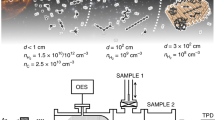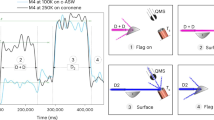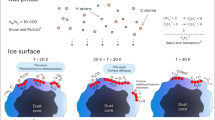Abstract
THE mechanisms of interstellar grain formation are not well understood. Such grains are complex1,2, with components that include silicates, ices and carbonaceous material. Several forms have been proposed for interstellar carbon, including graphite3, amorphous carbon4, polycyclic aromatic hydrocarbons (PAHs)5, diamond6, fullerenes7 and bacteria8. The stellar winds of carbon-rich red-giant stars are the dominant source of interstellar carbon grains9–11. However, the processes leading to the formation of grains are usually discussed only in the general terms of thermodynamics and classical nucleation theory12,13. One possibility9 is that PAH condensation initiates the formation of grains, similar to the formation of soot in hydrocarbon pyrolysis and combustion. Our recent computational study14 demonstrates by detailed chemical kinetics modelling that PAHs can, under certain conditions, form in carbon-star molecular envelopes within a 900–1,100-K temperature regime. Although homogeneous gas-phase condensation of PAHs might lead to the formation of grains, we suggest instead that SiC nucleates at higher temperatures and provides a surface for subsequent carbon condensation. Here we present experimental evidence in support of this idea.
This is a preview of subscription content, access via your institution
Access options
Subscribe to this journal
Receive 51 print issues and online access
$199.00 per year
only $3.90 per issue
Buy this article
- Purchase on Springer Link
- Instant access to full article PDF
Prices may be subject to local taxes which are calculated during checkout
Similar content being viewed by others
References
Tielens, A. G. G. M. & Allamandola, L. J. in Interstellar Processes (eds Hollenbach, D. J. & Thronson, H. A. Jr) 397–469 (Reidel, Dordrecht, 1987).
Mathis, J. S. Astrophys. Lett. Commun. 26, 239–248 (1988).
Draine, B. T. & Lee, H. M. Astrophys. J. 285, 89–108 (1984).
Duley, W. W. & Williams, D. A. Mon. Not. R. astr. Soc. 205, 67P–70P (1983).
Léger, A., d'Hendecourt, L. & Boccara, N. (eds) Polycyclic Aromatic Hydrocarbons and Astrophysics (Reidel, Dordrecht, 1987).
Saslaw, W. C. & Gaustad, J. E. Nature 221, 160–162 (1969).
Kroto, H. Science 242, 1017–1022 (1988).
Hoyle, F., Wickramasinghe, N. C., Al-Mufti, S., Olavesen, A. H. & Wickramasinghe, D. T. Astrophys. Space Sci. 83, 405–409 (1982).
Tielens, A. G. G. M. in Carbon in the Galaxy: Studies from Earth and Space (ed. Tarter, J.) (NASA Conference Publications, in the press).
Bode, M. F. in Dust in the Universe (eds Barley, M. E. & Williams, D. A.) 73–102 (Cambridge Univ. Press, 1988).
Jura, M. & Kleinman, S. G. Astrophys. J. (in the press).
Salpeter, E. E. Astrophys. J. 193, 585–592 (1974).
Gail, H. P. & Sedlmayr, E. Astr. Astrophys. 171, 197–204 (1987).
Frenklach, M. & Feigelson, E. D. Astrophys. J. (in the press).
Carmer, C. S. & Frenklach, M. Appl. Phys. Lett. 54, 1430–1432 (1989).
Frenklach, M. 22nd Int. Symp. on Combustion (The Combustion Institute, Pittsburgh, Pennsylvania, in the press).
Frenklach, M., Yuan, T. & Ramachandra, M. K. Energy & Fuels 2, 462–480 (1988).
Gilman, R. C. Astrophys. J. 155, L185–L187 (1969).
Friedemann, C. Physica 41, 139–143 (1969).
McCabe, E. M. Mon. Not. R. astr. Soc. 200, 71–92 (1982).
Gilra, D. P. Nature 229, 237–241 (1971).
Treffers, R. & Cohen, M. Astrophys. J. 188, 545–552 (1974).
Merrill, K. M. & Stein, W. A. Publs astr. Soc. Pacif. 88, 285–293 (1976).
Blanco, A. et al. in Experiments on Cosmic Dust Analogues (eds Bussoletti, E., Fusco, C. & Longo, G.) 167–173 (Kluwer Academic Publications, Dordrecht, 1988).
Strey, R., Wagner, P. E. & Schmeling, T. J. chem. Phys. 84, 2325–2335 (1986).
Tabayashi, K. & Bauer, S. H. in Proc. 12th Int. Symp. on Shock Tube and Waves (eds Lifshitz, A. & Rom, J.) 409–418 (Magnes, Jerusalem, 1980).
Marchand, A. in Polycyclic Aromatic Hydrocarbons and Astrophysics (eds Léger, A., d'Hendecourt, L. & Boccara. N.) 31–54 (Reidel, Dordrecht, 1987).
Deryagin, B. V. & Fedoseev, D. V. Growth of Diamond and Graphite from the Gas Phase (Nauka, Moscow, 1977).
Palmer, H. B. & Cullis, C. F. in Chemistry and Physics of Carbon (ed. Walker, P. L. Jr) 265–325 (Dekker, New York, 1965).
Tsuji, T. Astr. Astrophys. 197, 185–199 (1988).
Frenklach, M., Ting, L. & Palmer, H. B. Am. Inst. Chem. Eng. A. Meet. Paper 62j, Washington, DC (1988).
Sawano, K., Haggerty, J. S. & Bowen, H. K. Yogyo-Kyokai-Shi 95, 64–69 (1987).
Frenklach, M., Hsu, J. P., Miller, D. L. & Matula, R. A. Combust. Flame 64, 141–155 (1986).
Frenklach, M. in Carbon in the Galaxy: Studies from Earth and Space (ed. Tarter, J.) (NASA Conference Publications, in the press).
Popov, V. T. et al. Proc. Acad. Sci. U.S.S.R. (Phys. Chem. Sect.) 296, 923 (1987).
Frenklach, M. et al. J. appl. Phys. (in the press).
Frenklach, M. & Ebert, L. B. J. phys. Chem. 92, 561–563 (1988).
Messier, R. et al. Thin Solid Films 153, 1–9 (1987).
Angus, J. C. & Hayman, C. C. Science 241, 913–921 (1988).
Johnson, G. H., Badzian, A. R. & Geis, M. W. (eds) Diamond and Diamond-Like Materials Synthesis (Materials Research Society, Pittsburgh, 1988).
Nemanich, R. J., Glass, J., Lucovsky, G. & Shroder, R. E. J. Vac. Sci. Technol. A 6, Part 2, 1783–1785 (1988).
Ridgway, S. T. & Keady, J. J. Astrophys. J. 326, 843–858 (1988).
Bernatowicz, T. et al. Nature 330, 728–730 (1987).
Zinner, E., Tang, M. & Anders, E. Nature 330, 730–732 (1987).
Tang, M. & Anders, E. Geochim. cosmochim. Acta 52, 1235–1244 (1988).
Anders, E., Lewis, R. S., Tang, M. & Zinner, E. in Interstellar Dust (eds Allamandola, L. & Tielens, A.) (Reidel, Dordrecht, in the press).
Author information
Authors and Affiliations
Rights and permissions
About this article
Cite this article
Frenklach, M., Carmer, C. & Feigelson, E. Silicon carbide and the origin of interstellar carbon grains. Nature 339, 196–198 (1989). https://doi.org/10.1038/339196a0
Received:
Accepted:
Issue Date:
DOI: https://doi.org/10.1038/339196a0
This article is cited by
-
Interstellar Carbonaceous Dust and Its Formation Pathways: From an Experimental Astrochemistry Perspective
Journal of the Indian Institute of Science (2023)
-
A fresh mechanism for how buckyballs form in space
Nature (2019)
-
Nanocarbon synthesis by high-temperature oxidation of nanoparticles
Scientific Reports (2016)
-
Graphene etching on SiC grains as a path to interstellar polycyclic aromatic hydrocarbons formation
Nature Communications (2014)
-
Complementary and Emerging Techniques for Astrophysical Ices Processed in the Laboratory
Space Science Reviews (2013)
Comments
By submitting a comment you agree to abide by our Terms and Community Guidelines. If you find something abusive or that does not comply with our terms or guidelines please flag it as inappropriate.



